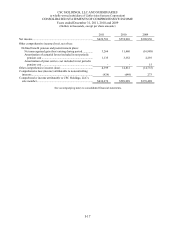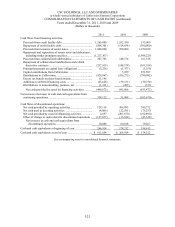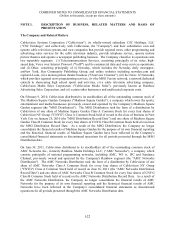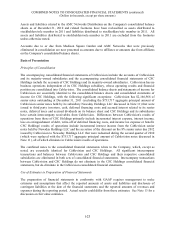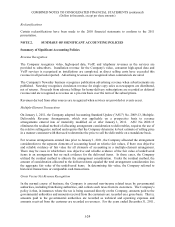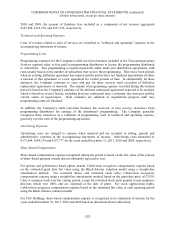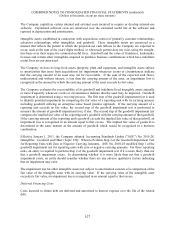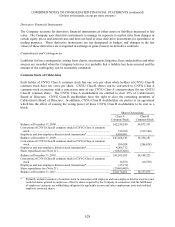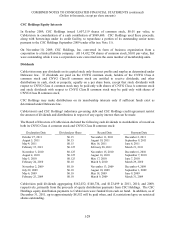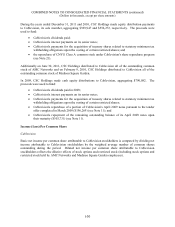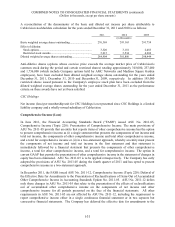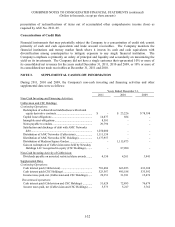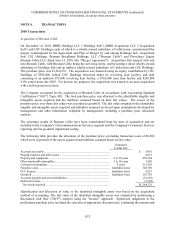Cablevision 2011 Annual Report Download - page 151
Download and view the complete annual report
Please find page 151 of the 2011 Cablevision annual report below. You can navigate through the pages in the report by either clicking on the pages listed below, or by using the keyword search tool below to find specific information within the annual report.COMBINED NOTES TO CONSOLIDATED FINANCIAL STATEMENTS (continued)
(Dollars in thousands, except per share amounts)
I-27
The Company capitalizes certain internal and external costs incurred to acquire or develop internal-use
software. Capitalized software costs are amortized over the estimated useful life of the software and
reported in depreciation and amortization.
Intangible assets established in connection with acquisitions consist of primarily customer relationships,
advertiser relationships, other intangibles, and goodwill. These intangible assets are amortized in a
manner that reflects the pattern in which the projected net cash inflows to the Company are expected to
occur, such as the sum of the years' digits method, or when such pattern does not exist, using the straight-
line basis over their respective estimated useful lives. Goodwill and the value of franchises, trademarks,
licenses and certain other intangibles acquired in purchase business combinations which have indefinite
useful lives are not amortized.
The Company reviews its long-lived assets (property, plant and equipment, and intangible assets subject
to amortization that arose from acquisitions) for impairment whenever events or circumstances indicate
that the carrying amount of an asset may not be recoverable. If the sum of the expected cash flows,
undiscounted and without interest, is less than the carrying amount of the asset, an impairment loss is
recognized as the amount by which the carrying amount of the asset exceeds its fair value.
The Company evaluates the recoverability of its goodwill and indefinite-lived intangible assets annually
or more frequently whenever events or circumstances indicate that the asset may be impaired. Goodwill
impairment is determined using a two-step process. The first step of the goodwill impairment test is used
to identify potential impairment by comparing the fair value of a reporting unit with its carrying amount,
including goodwill utilizing an enterprise-value based premise approach. If the carrying amount of a
reporting unit exceeds its fair value, the second step of the goodwill impairment test is performed to
measure the amount of goodwill impairment loss, if any. The second step of the goodwill impairment test
compares the implied fair value of the reporting unit's goodwill with the carrying amount of that goodwill.
If the carrying amount of the reporting unit's goodwill exceeds the implied fair value of that goodwill, an
impairment loss is recognized in an amount equal to that excess. The implied fair value of goodwill is
determined in the same manner as the amount of goodwill which would be recognized in a business
combination.
Effective January 1, 2011, the Company adopted Accounting Standards Update ("ASU") No. 2010-28,
Intangibles - Goodwill and Other (Topic 350): When to Perform Step 2 of the Goodwill Impairment Test
for Reporting Units with Zero or Negative Carrying Amounts. ASU No. 2010-28 modified Step 1 of the
goodwill impairment test for reporting units with zero or negative carrying amounts. For those reporting
units, an entity is required to perform Step 2 of the goodwill impairment test if it is more likely than not
that a goodwill impairment exists. In determining whether it is more likely than not that a goodwill
impairment exists, an entity should consider whether there are any adverse qualitative factors indicating
that an impairment may exist.
The impairment test for other intangible assets not subject to amortization consists of a comparison of the
fair value of the intangible asset with its carrying value. If the carrying value of the intangible asset
exceeds its fair value, an impairment loss is recognized in an amount equal to that excess.
Deferred Financing Costs
Costs incurred to obtain debt are deferred and amortized to interest expense over the life of the related
debt.


